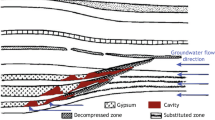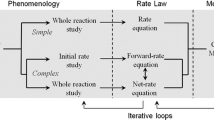Abstract
Recent improvements to experiments and modelling of batch dissolution in a turbulent reactor, based upon the shrinking object model, are extended to middle loadings of gypsum, that is, in the region between low and high loadings, which lead, respectively, to high under-saturation or saturation with a great excess of solid left undissolved. Dissolved calcium sulphate concentration was monitored by change in electrical conductivity. This investigation uses an improved, ion-pair model for CaSO 04 to allow for the presence of calcium or sulphate added as common ions. The study demonstrates that the full dissolution curve for 5.82 mM loadings of 106-μm particles of gypsum (~1.00 g L−1) in de-ionised water barely changed in the presence of either 4.64 or 8.09 mM calcium chloride, or 4.39 mM sodium sulphate. However, this masked a doubling of dissolution rate imposed by comparable increases in ionic strength from sodium chloride. The results are consistent with the ion pair, CaSO 04 , being the key species in the rate-determining step of the back-reaction, and perhaps all salt dissolutions, including calcium carbonate. In this case, the rate equation is as follows: \( {\frac{{{\text{d}}c}}{{{\text{d}}t}}} = \frac{S}{V} \cdot (k_{1} - k_{2}^{\prime } \cdot [{\text{CaSO}}_{ 4}^{0} ]) \), where k 1 and k 2′ are rate constants. The reported observations are interpreted as effects of ionic strength and common ion concentrations upon the formation equilibrium for the ion pair. This rate equation readily transforms mathematically to one involving the product of [Ca2+] and [SO4 2−] in the back-reaction. The parallel of this with the well-known PWP equation used in calcium carbonate dissolution is discussed, with the CaHCO3 + ion pair of the equation being replaced by that of CaCO 03 . Meanwhile, the earlier use of the product, [Ca2+]½ × [CO3 2−]½, in the back-reaction term of another dissolution rate equation for calcite is shown to be incorrect. Finally, it is argued that the shrinking object model should be repositioned as a logical derivative of the hydrodynamical approach to dissolution.








Similar content being viewed by others
References
Aagaard P, Helgeson HC (1982) Thermodynamic and kinetic constraints on reaction rates among minerals and aqueous solutions. 1. Theoretical considerations. Am J Sci 282:237–285
Atkins P, de Paula J (2002) Atkins’ physical chemistry. Oxford University Press, Oxford, UK
Balbach S, Korn C (2004) Pharmaceutical evaluation of early development candidates—“the 100 mg-approach”. Int J Pharmacy 275:1–12
Bircumshaw LL, Riddiford AC (1952) Transport control in heterogeneous reactions. Q Rev 6:157–185
Blum A, Lasaga A (1988) Role of surface speciation in the low-temperature dissolution of minerals. Nature 331:431–433
Colombani J (2008) Measurement of the pure dissolution rate constant of a mineral in water. Geochim Cosmochim Acta 72:5634–5640
Dove PM, Han N, De Yoreo JJ (2005) Mechanisms of classical crystal growth theory explain quartz and silicate dissolution behavior. PNAS 102:15357–15362
Dreybrodt W, Laukner J, Zaihua L, Buhmann D (1996) The kinetics of the reaction CO2 + H2O → H+ + HCO3 − as one of the rate limiting steps for the dissolution of calcite in the system H2O-CO2-CaCO3. Geochim Cosmochim Acta 60:3375–3381
Greenwood JE, Truesdale VW, Rendell AR (2001) Biogenic silica dissolution in seawater—in vitro chemical kinetics. Prog Oceanogr 48:1–23
Helgeson HC, Murphy WM, Aagaard P (1984) Thermodynamic and kinetic constraints on reaction rates among minerals and aqueous solutions. II. Rate constants, effective surface area, and the hydrolysis of feldspar. Geochim Cosmochim Acta 48:2405–2432
Ichenhower JP, McGrail BP, Shaw WJ, Pierce EM, Nachimuthu P, Shuh DK, Rodriguez EA, Steele JL (2008) Experimentally determined dissolution kinetics of Na-rich borosilicate glass at far from equilibrium conditions: implications for transition state theory. Geochim Cosmochim Acta 72:2767–2788
Jeschke AA, Dreybrodt W (2002) Dissolution rates of minerals and their relation to surface morphology. Geochim Cosmochim Acta 66:3055–3062
Jeschke AA, Vosbek K, Dreybrodt W (2001) Surface controlled dissolution rates of gypsum in aqueous solutions exhibit nonlinear dissolution kinetics. Geochim Cosmochim Acta 65:27–34
Kamatani A, Riley JP, Skirrow GJ (1980) The dissolution of opaline silica of diatom tests in seawater. Oceanogr Soc Jpn 36:201–208
Krauskopf KB (1979) Introduction to geochemistry. McGraw-Hill, New York
Lasaga AC (1981) Transition state theory. In: Lasaga AC, Kirkpatrick RJ (eds) Kinetics of geochemical processes. Reviews in mineralogy, vol 8. Minerological Society of America, Washington, DC, pp 261–319
Liu Z, Dreybrodt W (1997) Dissolution kinetics of calcium carbonate minerals in H2O–CO2 solutions in turbulent flow: the role of the diffusion boundary layer and the slow reaction H2O + CO2 ↔ H+ + HCO3 −. Geochim Cosmochim Acta 61:2879–2889
Nagy KL, Lasaga AC (1992) Dissolution and precipitation kinetics of gibbsite at 80°C and pH 3: the dependence on solution saturation state. Geochim Cosmochim Acta 56:3093–3111
Nernst W (1904) Theorie der Reaktionsgeschwindigkeit in heterogenen Systemen. Zeitshcrift Phys Chem 47:52–55
O’Connor TL, Greenberg SA (1958) The kinetics for solution of silica in aqueous solutions. J Phys Chem 63:1195–1198
Plummer LN, Wigley TML (1976) The kinetics of calcite dissolution in CO2-saturated solutions at 25°C and 1 atmosphere total pressure. Geochim Cosmochim Acta 40:191–202
Plummer LN, Wigley TML, Parkhurst DL (1978) The kinetics of calcite dissolution in CO2-water systems at 5°C to 60°C and 0.0 to 1 atm. CO2. Am J Sci 278:179–216
Raines MA, Dewers TA (1997) Mixed transport/reaction control of gypsum dissolution kinetics in aqueous solutions and initiation of gypsum karst. Chem Geol 140:29–48
Rickard D, Sjöberg EL (1983) Mixed kinectic control of calcite dissolution rates. Am J Sci 283:815–830
Rickert D, Schulter M, Wallmann K (2002) Dissolution kinetics of biogenic silica in aqueous solutions. Geochim Cosmochim Acta 66:439–455
Sjöberg EL (1976) A fundamental equation for calcite dissolution kinetics. Geochim Cosmochim Acta 40:441–447
Sjöberg EL, Rickard D (1983) The influence of experimental design on the rate of calcite dissolution. Geochim Cosmochim Acta 47:2281–2285
Sjöberg EL, Rickard D (1985) The effect of added dissolved calcium on calcite dissolution kinetics in aqueous solutions at 25°C. Chem Geol 49:405–413
Skoog DA, West DM, Holler FJ (1996) Analytical chemistry. Saunders College Publishing, London
Sohn HY, Wadsworth ME (1979) Rate processes in extractive metallurgy. Plenum, New York. ISBN 0 306 31102-X
Tanji KA (1969) Solubility of gypsum in aqueous electrolytes as affected by ion association and Ionic strengths up to 0.15 M and at 25°C. Environ Sci Technol 3:656–661
Truesdale VW (2007) Batch dissolution kinetics: the shrinking sphere model with salts and its potential application to biogenic silica. Aquat Geochem 13:267–287. doi:10.1007/s10498-007-9020-1
Truesdale VW (2008) Shrinking sphere kinetics for batch dissolution of mixed particles of a single substance at high under-saturation–validation with sodium chloride, but with biogenic silica in mind. Aquat Geochem 14:359–379. doi:10.1007/s10498-008-9041-4
Truesdale VW (2009) Sucrose dissolution studies leading to a generic Shrinking Object model for batch dissolution of regular-shaped particles. Aquat Geochem 15:421–442. doi:10.1007/s10498-008-9059-7
Truesdale VW (2010a) Generic issues of batch dissolution exemplified by gypsum rock. Aquat Geochem (in press)
Truesdale VW (2010b) Silica gel as a surrogate for biogenic silica in batch dissolution experiments at pH 9.2: further testing of the Shrinking Object Model and a novel approach to the dissolution of a population of particles. Aquat Geochem 16:101–126. doi:10.1007/s10498-009-9072-5
Truesdale VW, Greenwood JE, Rendell AR (2005a) The rate-equation for biogenic silica dissolution in seawater—New hypotheses. Aquat Geochem 11:319–343. doi:10.1007/s10498-004-7921-9
Truesdale VW, Greenwood JE, Rendell AR (2005b) In vitro, batch-dissolution of biogenic silica in seawater—the application of recent modelling to real data. Progr in Oceanogr 66:1–24. doi:10.1016/j.pocean.2005.02.019
Van Cappellen P, Qiu L (1997) Biogenic silica dissolution in sediments of the Southern Ocean. II. Kinetics. Deep-Sea Res II 44:1129–1149
Acknowledgments
Thanks go to Stephen Casterton, Regional Technical Service Manager, BPB (Newark, UK), for generously supplying the gypsum rock and to Professor Linda King, Dean of the School of Life Sciences, Oxford Brookes University, for her support. Thanks go to Professor George Luther for his sustained support, especially during the project’s infancy. Thanks go to Professors Mike Whitfield and Heinz Gamsjäger for useful discussions, and to two anonymous referees whose comments have improved the paper enormously.
Author information
Authors and Affiliations
Corresponding author
Rights and permissions
About this article
Cite this article
Truesdale, V.W. Rate Equations and an Ion-pair Mechanism for Batch Dissolution of Gypsum: Repositioning the Shrinking Object Model at the Core of Hydrodynamic Modelling. Aquat Geochem 17, 141–164 (2011). https://doi.org/10.1007/s10498-010-9112-1
Received:
Accepted:
Published:
Issue Date:
DOI: https://doi.org/10.1007/s10498-010-9112-1




